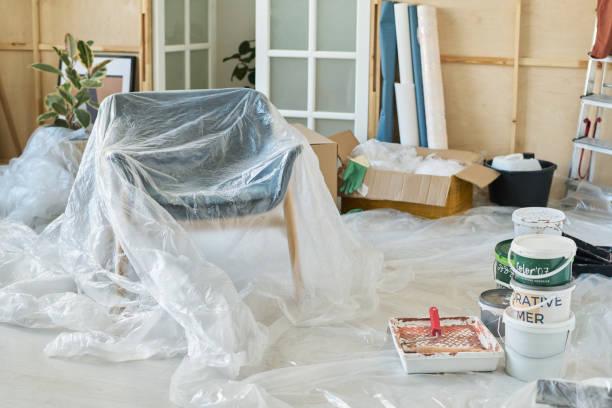When it comes to painting — whether it’s touching up a wall indoors or refreshing an exterior fence — protecting your floors, furniture, and landscaping is essential. That’s where painters tarps come into play. These durable covers prevent paint spills, drips, and dust from damaging surfaces during both indoor and outdoor projects.
Choosing the right painter’s tarp can make the painting process cleaner, faster, and more professional. But not all tarps are created equal. Some are better suited for hardwood floors, while others are built to handle wind, weather, and uneven outdoor terrain. This guide breaks down the top 5 types of painter’s tarps you should consider for your next painting project — based on material, use case, and protective capabilities.
1. Heavy-Duty Canvas Tarps for Reusability and Superior Absorption
Canvas tarps are among the most popular choices for professional painters due to their durability and absorbent nature. Made from tightly woven cotton, these tarps are thick enough to soak up paint drips and heavy enough to stay in place without the need for excessive taping or weights.
Ideal for:
-
Interior wall painting
-
Ceiling work
-
Long-term, reusable coverage
Benefits:
-
Absorbs paint without allowing it to seep through
-
Washable and reusable for multiple projects
-
Non-slip texture makes them safer on floors
-
Durable enough to withstand heavy foot traffic
Canvas tarps are especially helpful when painting large indoor areas or high-traffic rooms, where protection and slip-resistance are equally important.
2. Polyethylene Tarps for Waterproof Protection in Outdoor Settings
Poly tarps, made from plastic materials like polyethylene or polypropylene, are waterproof, tear-resistant, and UV-protected — making them excellent for outdoor painting projects. Their non-porous surface prevents water or paint from seeping through, offering a dependable shield against unpredictable weather conditions.
Ideal for:
-
Fence or siding painting
-
Outdoor furniture protection
-
Covering plants or landscaping near painted surfaces
Benefits:
-
100% waterproof and UV-resistant
-
Lightweight but highly durable
-
Easy to secure with grommets and rope
-
Easy to clean with just a hose
Poly tarps are also resistant to mildew and mold, which adds longevity and keeps them safe for repeated outdoor use.
3. Butyl-Backed Drop Cloths for Maximum Spill Resistance
Butyl-backed painter’s tarps are designed with a blend of fabric on the top layer and a rubberized butyl backing on the underside. This hybrid construction makes them nearly impenetrable by any kind of spill — including thick latex paints or oil-based products.
Ideal for:
-
High-risk spill zones like staircases
-
Commercial or industrial painting sites
-
Painting projects with spray guns or high-volume rollers
Benefits:
-
Leakproof bottom prevents floor staining
-
Stays in place without bunching or curling
-
Offers noise dampening on hard surfaces
-
Suitable for use on tile, wood, or carpet
These tarps are often heavier, making them less portable, but they provide unbeatable protection in environments where spills are frequent or hazardous.
4. Plastic Sheeting for Quick Covering and Disposable Use
If you’re working on a one-time painting job or need to quickly cover furniture, floors, or fixtures, plastic sheeting offers a lightweight, affordable solution. Typically made from polyethylene, plastic sheeting is transparent and comes in a roll, making it easy to cut and fit into tight or irregular spaces.
Ideal for:
-
Furniture and wall protection during prep
-
Temporary window masking
-
Light-duty indoor projects
Benefits:
-
Extremely lightweight and easy to handle
-
Budget-friendly and disposable
-
Great for taping or draping over irregular items
-
Comes in various thickness levels (measured in mils)
Although plastic sheeting isn’t absorbent or reusable like canvas, it’s excellent for minimizing cleanup during small or medium-sized tasks.
5. Mixed-Fabric Tarps for Versatile Coverage and Balanced Performance
Some tarps are made from a combination of cotton, polyester, and synthetic backing. These hybrid tarps offer a balance between absorbency, durability, and waterproofing. They tend to be lighter than canvas but offer more protection than basic plastic sheeting.
Ideal for:
-
DIY projects with kids or pets nearby
-
Apartment or rental painting jobs
-
Covering multiple surfaces with a single product
Benefits:
-
Lighter than traditional canvas
-
Resists tearing and puncturing
-
Absorbs light spills while offering moderate waterproofing
-
Often machine washable for reusability
Mixed-fabric painter’s tarps are a solid choice for homeowners looking for one tarp to do it all, especially for medium-duty applications both indoors and outdoors.
Key Features to Consider When Choosing a Painter’s Tarp
No matter what type of tarp you choose, there are a few essential features you should evaluate before making a purchase:
-
Size and Coverage Area: Measure the area to be protected and select a tarp that covers beyond the working space.
-
Thickness and Material Weight: Thicker tarps provide better protection but may be harder to maneuver. Look for a balance based on the project.
-
Grip and Slip Resistance: Especially important for indoor use where people will be walking on the tarp.
-
Waterproof or Absorbent Properties: Choose based on whether you need to block spills or absorb them.
-
Ease of Cleaning and Storage: Consider if the tarp is disposable or reusable and how easy it is to clean for future use.
Safety Tips When Using Painter’s Tarps
Using tarps properly can prevent accidents and ensure optimal coverage during your painting projects. Follow these tips for safe usage:
-
Secure edges with painter’s tape or weights to prevent tripping.
-
Avoid using plastic sheeting on hard floors where it can become slippery.
-
Fold and store tarps cleanly after use to maintain their lifespan.
-
Do not overload tarp surfaces with paint trays or tools that may tip over.
-
Use multiple tarps for layered protection if working with strong chemicals or spray paint.

